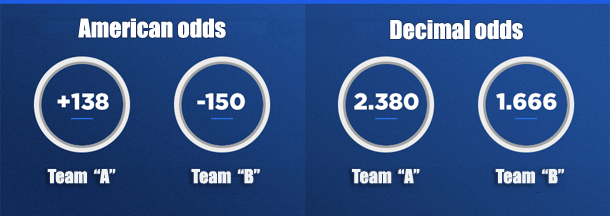What are the Odds and How to Calculate them
Have you ever wondered, what is the essence of a specific odd, what does it show? How is it formed? This article will take a closer look at the nature and types of odds. But let’s start with a brief introduction to the topic.

We all know what does a chance mean but how is it calculated?
Outside the world of betting, the chance is measured in percentages. For example, if you throw a coin, the chance for a tail is 50%, and the one for a head is also 50%. We have two possible outcomes of which total chance is 100%. Remember that the sum of all possible results (expressed in percentages) for each event is equal to 100%!
Odds are a reflection of the chance or the possibility for a certain outcome of an event! In any event, each outcome has a certain chance to happen. Odds are interpretations of those chances, i.e. bookmakers form odds by which they determine the chances of an event’s result.
For instance:
Suppose that we have the match Chelsea – Norwich.
The bookmaker sets the chance, Chelsea, to win to be 75% and chance Norwich to win – 5% and therefore, the possibility of the match to end in a draw is 20%. (The sum of all chances equals 100%)
In this way the aforementioned chances would have odds as follows:
- Chelsea to win the match – 1.33
- Norwich to win the match – 20
- A draw – 5
Using such methods, the bookmakers provide you with multiple markets of different odds and betting opportunities.
After we got to know the way of forming odds, let’s look at what kinds of odds there are and how to understand them. Because bookmakers do not use percentages to express the chances of an event’s outcome, there are several odds by which they can do so.
There are three types of odds – decimal, fractional and American. Let’s start with the decimal odds.
Decimal Odds
Decimal odds are mainly used in Europe and therefore are also known as European odds. To calculate chance in a decimal odd, we simply divide 100 by a chance expressed in a percentage. Or the formula would look like this: ch is 102 * (50/100).
% = Coefficient
If you think that a team has a 20% chance to win, then we have 100/20 = 5, i.e. the odd at which we can bet is 5.
Suppose that you have bet on an event which has decimal odds of 4.0. If your prediction is successful, for every pound, you have bet, you will receive £4 profit. If you bet £5 at these odds, you will earn £20. As you can see your bet is included in the odd.
Decimal bet multiplied by your stake shows your profit. The odds show how many times the bookmaker pays for each unit amount you have wagered.
Fractional Odds
The next type of odds is the so-called fractional odds. These are commonly used in the UK.
Again, we will use the example of a chance of winning that equals 20%. With fractional odds that probability will be expressed as 4/1. This odd indicates that for every time you win, you will then lose 4 times. This is the same as to say that we have a 20% chance of winning and therefore 80% chance of losing.
Let’s say you bet on an event with fractional odds 5/1. If your bet is successful, for each pound you bet, you will win £5 and get your bet pound back, which means that the total amount is £6. If you bet £5 at fractional odds of 5/1, your profit is equivalent to £25 plus the £5 you have placed, which makes a total profit of £30.
Fractional odds multiplied by your stake show your profits. Odds show how many units you win in terms of winning one unit of a bet.
American Odds
If you wish to bet on American sports, you should definitely understand American odds. American odds can also be found as lines or money lines.
If American odds are indicated (listed) with the plus sign, then they show the amount you would win with 100 bets. If there is a minus sign, then odds show how much you need to bet to win 100.
If you bet on an event with decimal odds of 5.0 or fractional odds 4/1, the American odds will be + 400. If you bet on decimal odds 1.5, respectively fractional odds will be ½. Therefore the American odds will be -200.
American odds can be divided into positive and negative. Negative odds show what stake you need to win 100 units. Positive odds show how big your winnings could be if you bet 100 units.
In the bookmakers’ companies you usually have the option to choose in what type of odds to see the possible outcomes of different events, but knowing all three kinds of odds and understanding them makes you a more worthy player.
However, if you experience difficulties with any of the types of odds, you can look for an online converter will show you, for instance, what American odds will look like as decimal or fractional.
How to calculate your profits with different types of odds?
There are different types of betting odds, depending on which part of the world you live, and you’re your preference for using them. The two main types of betting odds are Decimal odds and American odds, but what is the difference between them and how to calculate profits when using different types of odd? Read further to find out.
Before we show examples on how to calculate profits in different types of odds, it is important to note that regardless of what odds we present, the potential benefit is one and the same, just the way of showing them is different.
Calculating profits with Decimal Odds:
Decimal odds are predominantly used in continental Europe, Australia and Canada. The form of this type of odds is a simple digital presentation of the expected profit from a bet, which includes the amount of the stake. The potential return of decimal odds is effortless to calculate: simply multiply the amount you want to bet on the offered decimal odds – just remember that the return includes the amount of the stake.
| Teams | Handicap | 1X2 | GOALS |
|---|---|---|---|
| Villarreal CF | – | 1.865 | under/over |
| Sevilla FC | – | 4.720 | under/over |
| DRAW | – | 3.580 | under/over |
Using the decimal odds example above, if you bet £100 on Villarreal, the potential return would be £188.50.
Odds X stake = 1.865 X £100. = £188.50
This includes the £100 you have placed as a bet, so potentially your net profit is £88.50.
If you bet £100 on Sevilla, the potential return will be £485.
Calculating profits with American Odds
Not surprisingly, American odds are the preferred form of odds in the US. The odds may have a positive or negative sign like -110 or + 120. The negative figure indicates what you need to bet to earn £100 (or the equivalent of the currency of your choice), and the positive figure indicates how much profit you can earn if you bet £100.
| Teams | Handicap |
|---|---|
| New England Patriots | +3 -120 |
| Philadelphia Eagles | -3 +112 |
If you bet £110 on a team with American odds of -110 and the team wins, you will earn a profit of £100 (plus your £110 that you have placed as a bet).
If you bet £100 on a team with odds of +120, and that team wins, it will bring you a profit of £120 (plus your £100 that you have placed as a bet).
When using the American odds, the winner of the match on the betting market is known as the money line.
Calculating odds – positive moneyline:
Odds x (bet / 100)
Calculating odds – negative moneyline:
(100 / odds) x bet
Example of a Moneyline
| Players | Odds |
|---|---|
| Rafael Nadal | -108 |
| Roger Federer | 102 |
You do not have to bet an amount of money equal to the figure of the monetary line. You can bet more, or less, with the return of your chosen bet. Using the above example, you can bet £10.80 on Nadal at odds of negative money line -108 and your potential profit will be £10, i. e. (100 / Negative money line) * bet, which is (100/108) * 10.80.
Using the same example of positive odds, you can bet £50 on Roger Federer at odds of positive money line +102 and your potential profit would be £51, i.e. the positive money line * (bet / 100), which is 102 * (50/100).
